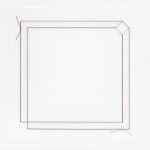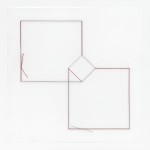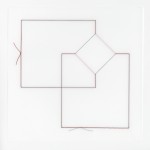Circuit Drawings, 2015
The Wheatstone Bridge, invented by Samuel Hunter Christie in 1833 and improved and popularized by Charles Wheatstone in 1843, is a bridge circuit originally developed to measure resistance to direct current. It has also been used to measure impedance in alternating current circuits. Typically, the circuit is diagramed showing the bridge as a straight line between nodes at the mid-point of the two parallel branches (the diamond shape) of the circuit. However, the bridge is sometimes extended to a loop or rectangle similar in appearance to the branch containing the voltage source. It is this alternate diagram on which I have based these drawings.
The two threads—red and gray—move through the circuit as alternating current would flow, each taking a different route through the diamond shaped parallel branches of the circuit. By piercing the polyester sheet, the threads exchange places—front to back—as they flow in opposite or alternating directions.
Exhibited:
Endless, Entire; FiveMyles, Brooklyn, N.Y., 2015
The Onward of Art: American Abstract Artists 80th Anniversary Exhibition; 1285 Avenue of the Americas Gallery, N.Y., N.Y.; 2016
Passing Through; Schema Projects, Brooklyn, N.Y.; 2016
- Wheatstone Bridge 1b
- Wheatstone Bridge 2b
- Wheatstone Bridge 2b (detail)
- Wheatstone Bridge 3a
- Wheatstone Bridge 4a
- Wheatstone Bridge 5a
- Wheatstone Bridge 7a






